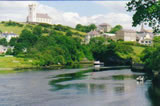
|
|
Salmon Deaths in Ireland Experts Baffled While Fish Die The salmon are dying. In the estuary. In the tailrace. In artificial Assaroe Lake. The latest outbreak occurred in July of this year. Dead salmon were found floating in the Erne estuary, yards from historic Inis Saimer. They had survived migration to the seas off Greenland, were returning to spawn where they themselves were hatched, only to die before they could make their passage through the tailrace and the fish pass. Itís not the first time this has happened since the ESB (Electricity Supply Board) built a dam at Cathleenís Falls on the River Erne just above the town of Ballyshannon in County Donegal. It wonít be the last time either. A similar "unfortunate event" took place in 2000. Their natural path upriver was disrupted when the waterflow over Assaroe Falls, below the town of Ballyshannon, was diverted into a tailrace, leading to a fish pass that was supposed to guarantee them passage to their eons-old spawning grounds. The immediate impact was devastating. (See "The Day the Salmon Died"). The long-term impact is with us to this day. Until an all-out effort is made, not by local people alone, not just by fishermen, anglers, concerned environmentalists, and tourism promoters, but all of the foregoing, joined by civic leaders at the municipal, county, national and international levels, the salmon will continue to be at risk. But there is hope. The plight of the Atlantic salmon returning to the River Erne is no longer known only to local anglers and fishermen. Media attention has focused attention on the salmon of the Erne, on Ballyshannon, and on the need for the rehabilitation of the lower Erne from the Cathleenís Falls dam down to the estuary. Those who thought the salmon run would survive the loss of the Falls, and a poorly, very poorly designed fish pass, have been proven wrong, cycle after cycle. Efforts have been to promote fish stock by aquaculture, but the wild Atlantic salmon have repeatedly fallen prey to disease, and the experts are puzzled. For two seasons experts at the Irish Marine Institute, the Northern Fisheries Board, the Electricity Supply Board, and the Veterinary Science Laboratory in Belfast, have been engaged in a study trying to determine what is causing the salmon to die after they enter the riverís estuary and swim upriver. To date a number of hypotheses have been put forward, including water temperature, waterflow, and the design of the fish pass. Singly or in combination they could be the cause. And what do these three suspects have in common? They are an interference with the natural order. We, globally, pollute the atmosphere, raising temperature. We, through the ESB, control the waterflow. We, through the ESB, control the fish pass. A picture is emerging. We cannot control global warming--yet. But what we can control, we should control. And that means controlling the ESB, which controls the waterflow and the fish pass. For far too long local interests and local habitat have suffered as a result of decisions made by this semi-state body. Its behaviour can no longer be tolerated, whether in fish management or in pylonisation, from Donegal to Cork harbour. A plan has recently been proposed to rehabilitate the lower Erne and provide a refuge for its spawning salmon. It provides a natural solution to a man-made disaster. Such rehabilitation has been successfully undertaken in other salmon streams and rivers. Those who are newcomers to this site may find it outlined in the item Ballyshannon at the Crossroads. Adoption of the plan can mean the survival of the salmon, for us and for our descendants.
These two lines, written by the poet Donagh MacDonagh, sum up the regard held by many for what have been called "the Kings of the Fish". You are invited, indeed urged, to read the accompanying excerpts from the "Donegal Bay Angling Guide" compiled by Paddy Donagher, which are to be found in the history section on this site. Mr. Donagher, a resident of Ballyshannon and member of the local Anglers' Association, was among those who first brought attention to the dead salmon floating in the Erne estuary below the tailrace. His history of the salmon fishery on the Erne is well researched and written. It may be of assistance were the authorities to investigate the possibility of untreated effluent being discharged into the tailrace from its northern bank. If such were the case, the Great Pool below the desecrated Falls of Assaroe faces the danger of becoming the Great Cess Pool, a danger to both salmon and humans. The recent e-coli disaster at Walkerton, Ont., Canada, which caused the deaths of seven people and the illness of several hundred others, is still fresh in memory. The photograph below (courtesy Camera World, Ballyshannon) shows the Great Pool which once teemed with healthy salmon as they prepared to leap the Falls.

Click for larger image
Home | About | Canadian Vindicator | Literature | Gallery | History
|
||||||||||||||||||||||||||||||||||||||||||||||||||||||||||||||||||||||||||||||||||||